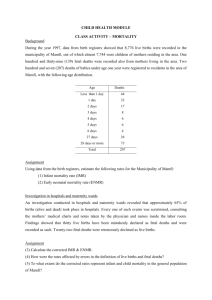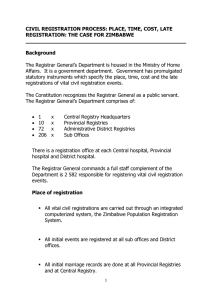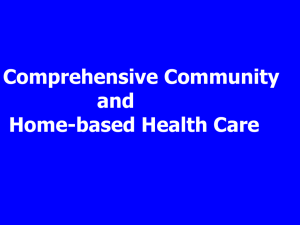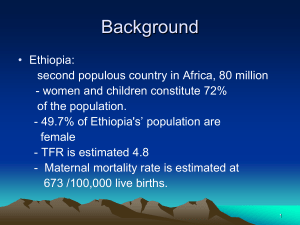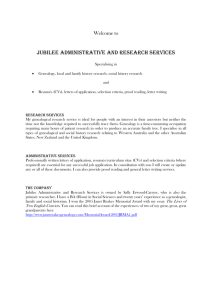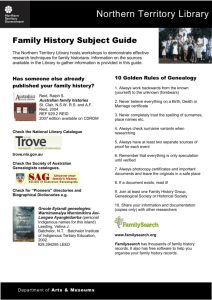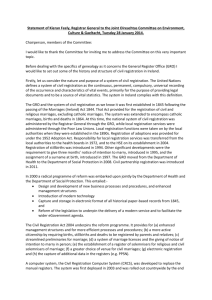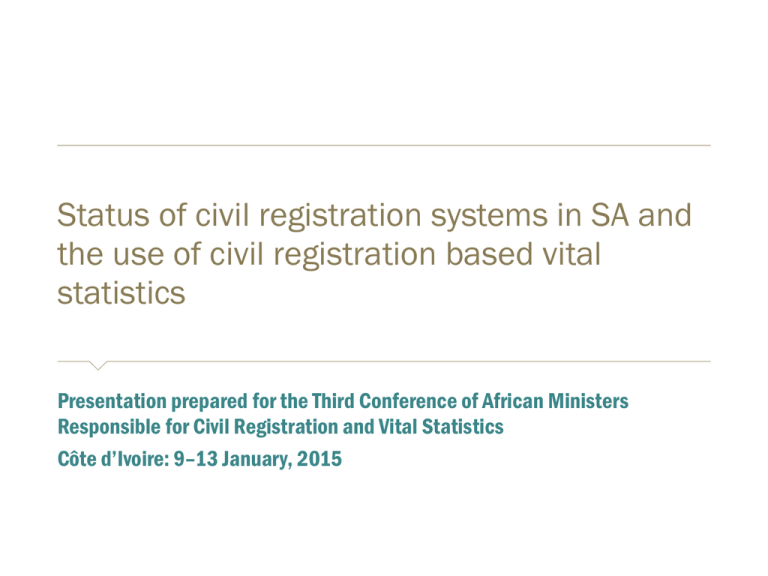
Status of civil registration systems in SA and
the use of civil registration based vital
statistics
Presentation prepared for the Third Conference of African Ministers
Responsible for Civil Registration and Vital Statistics
Côte d’Ivoire: 9–13 January, 2015
Current Footprint status
Offices are categorised by type
of office:
-Local office Large – serving
about 400 000 pop per
annum
-Local office Medium – 160
000 pop
-Local office Small – 40 000
pop
Province
EC
FS
GP
KZN
LP
MP
NC
NW
WC
TOTAL
LOCAL OFFICE LOCAL OFFICE
LARGE
MEDIUM
6
24
3
9
23
8
18
8
19
5
21
3
7
3
13
3
12
5
44
146
LOCAL OFFICE LOCAL OFFICE
SMALL (PSP)
SMALL (TSC)
23
11
6
32
21
19
5
2
0
119
6
7
24
18
12
15
3
4
9
98
TOTAL
59
30
61
76
57
58
18
22
26
407
Rural / Urban division of current offices
PROVINCE
EC
FS
GAUTENG
KZN
LP
MP
NC
NW
WC
Grand
Total
LOCAL OFFICE LARGE
RURAL
URBAN
0
6
0
3
0
8
1
7
0
5
0
3
0
3
0
3
0
5
1
43
LOCAL OFFICE MEDIUM
URBAN
RURAL
9
15
6
3
21
2
12
6
6
13
10
11
1
6
5
8
7
5
69
77
LOCAL OFFICE SMALL
(PSP)
URBAN
RURAL
1
22
0
11
6
3
29
2
19
1
18
1
4
0
2
0
105
14
LOCAL OFFICE SMALL
(TSC)
RURAL
URBAN
6
5
2
2
22
16
2
12
15
1
2
4
8
1
69
3
29
Grand Total
59
30
61
76
57
58
18
22
26
407
Birth registration: online health facilities
Financial Year
Hospitals to be
Number of Health
Total Health
Number of Health
2009/10
connected in
Facilities
Facilities
Facilities where
Total Health
Facilities where
manual collection
births are
is conducted
registered
terms of the
Strategic Plan
connected and
Operational
Connected
2009/10
No target set
50
128
127
255
2010/11
120
44
172
114
286
2011/12
126
84
256
88
344
2012/13
80
89
345
77
422
2013/14
2014/15
40
0
44
0
389
389
69
69
458
458
Health facilities
currently online (
cumulative)
Rural
Urban
Nr
connected
during the
financial
year.
2009/2010
128
36
14
50
2010/2011
172
20
24
44
2011/2012
256
37
47
84
2012/2013
345
48
41
89
2013/2014
389
23
21
44
Year of health
facility
connectivity
COMPARISON LIVE BIRTHS DoH AGAINST DHA BIRTH REGISTRATIONS
Birth registrations by status of
registration
241 677
2012
late
registration
s
1 in 5
926 726
births registered
during 2012 were
registered late
current
registrations
1 168 403
total
registrations
Number of birth registrations, 1992-2012
1. Total registration
2. Late registration
3. Current registration
In 1998, 78% of registrations were late
In 2012, this has dropped to 21%
Percentage of births by month (2008-2012)
Declining LRB applications
The above decline in LRB applications is attributed to outreach programmes & campaigns
South Africa’s Identity documents life cycle
•
Reference Book (Apartheid era identity)
•
•
•
1960- 1986
Green Barcoded ID Book
•
Turnaround time unknown
•
•
1986-2013
Turnaround time 54 working days
•
Smart ID Card
•
2013- beyond
Secure has the option for additional Government
services on the chip
•
Turnaround time 10-15 working days
Smart ID Card/
Passport Process
Government Printing Works
Citizens
1
8
2
3
Track n trace
NPR & HANIS (National
Identification System
once modernized)
4
5
6
Front Offices
7
sms
notification
Couriering to
front offices
140 Offices envisaged to be operational with live capture 2014/15)
Incentives for birth registration and ID
Social grants
Registration of children at school
Voter registration
Registration at tertiary
Social services
Banks
Death registration of adults is
77%
94%
complete
of deaths were registered within
the 3 Days of death as stipulated
within the legislation in 2013 it
was 74.9% in 2012
• Statistics compiled in accordance with WHO standards
General improvements noted in the quality of data
In 2013,
458 933
deaths
occurred in South Africa
700,000
600,000
Number of deaths
500,000
400,000
300,000
200,000
Decline in
recorded
deaths
continues
100,000
1997 1998 1999 2000 2001 2002 2003 2004 2005 2006 2007 2008 2009 2010 2011 2012 2013
Year of death
HANIS Production Transactions on Banks
Period
ABIL
ABSA
BIDVEST
FNB
NED
SBSA
Total
1 April to 30 April
2014
343808
169081
9254
209529
111531
2120
845323
1 May to 25 May
2014
213106
92717
5581
124306
73907
839
510456
26 May to 29 June
2014
278174
150397
7963
190790
137174
1168
765666
30 June to 27 July
2014
191047
124815
6594
176278
137963
549
637246
28 July to 31
August 2014
210488
196642
7812
230340
184930
591
830803
1 Sep to 30 Sep
2014
262019
173720
7653
191015
222054
526
856987
1 Oct to 30 Oct
2014
161929
179702
8343
197033
205406
505
752918
1 Nov to 24 Nov
2014
121968
113209
5923
141257
161419
370
538223
1 Dec to 31 Dec
2014
177858
151689
8695
296201
225451
278
851477
1 Jan to 31 Jan
2015
164091
202268
6033
336953
282973
233
992551
TOTAL
7581650
Importance of death/stillbirths registration
for vital statistics
Based on data from the death registration system at the Department of Home
Affairs.
Derive information on the number of deaths/stillbirths (and their causes)
registered each year:
Age and sex of deceased, geographic information, causes of death (natural
vs unnatural), etc
It is used as a source of statistical information on mortality and causes of death:
Evaluating, monitoring and improving the health of the population
MDGs – CRVS used to derive the following indicators in the SA 2013 MDG report
(Under five mortality rate, infant mortality rate and maternal mortality ratio)
Informing decisions on health policy and strategy
Importance of birth registration for vital
statistics
Based on data from the birth registration system at the Department of
Home Affairs.
Derive information on the number of births registered each year:
Date of birth
Sex of child
Particulars of parents
Geographic information
Information on births is used as :
Measure of fertility
denominators for the rates from the census and survey data to produce rates
on mortality
Importance of marriage registration for vital
statistics
Based on data from the marriage registration systems at the Department
of Home Affairs.
Civil marriages
Customary marriages
Civil unions
Derive information on the following:
Age at marriage and age differences between spouses
Marital status at the time of marriages
Geographic information on marriages
Trends in registrations
It is used as a source of statistical information on family formation and
Important Announcement
With effect from 01 June 2015 everyone
travelling with children under 18 years to and
from South Africa will be required to produce
unabridged birth certificates for those
children.
21


